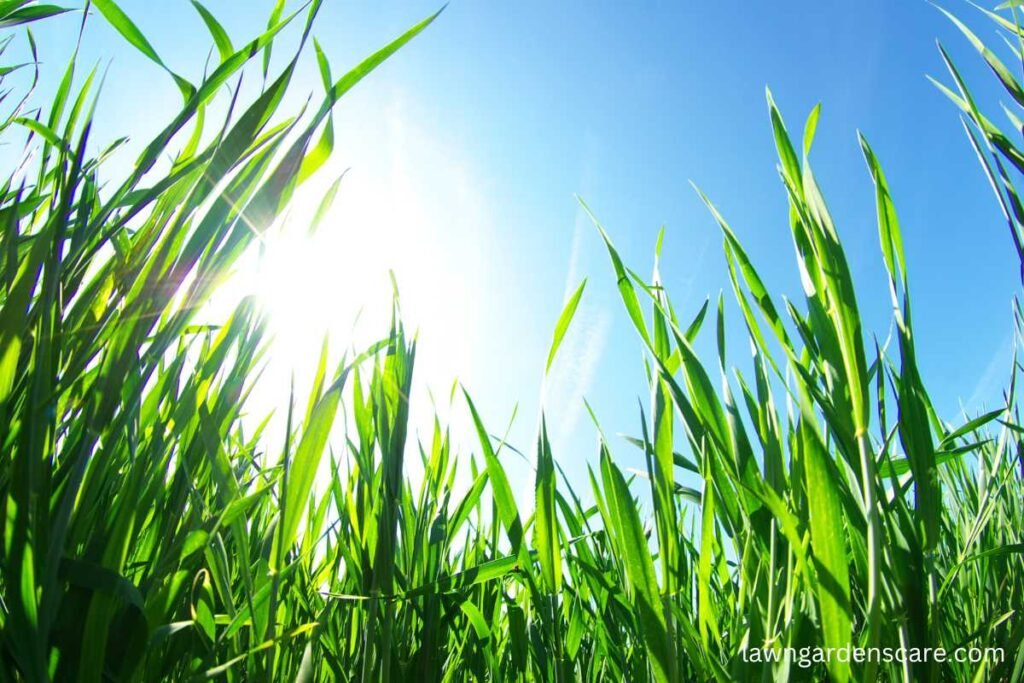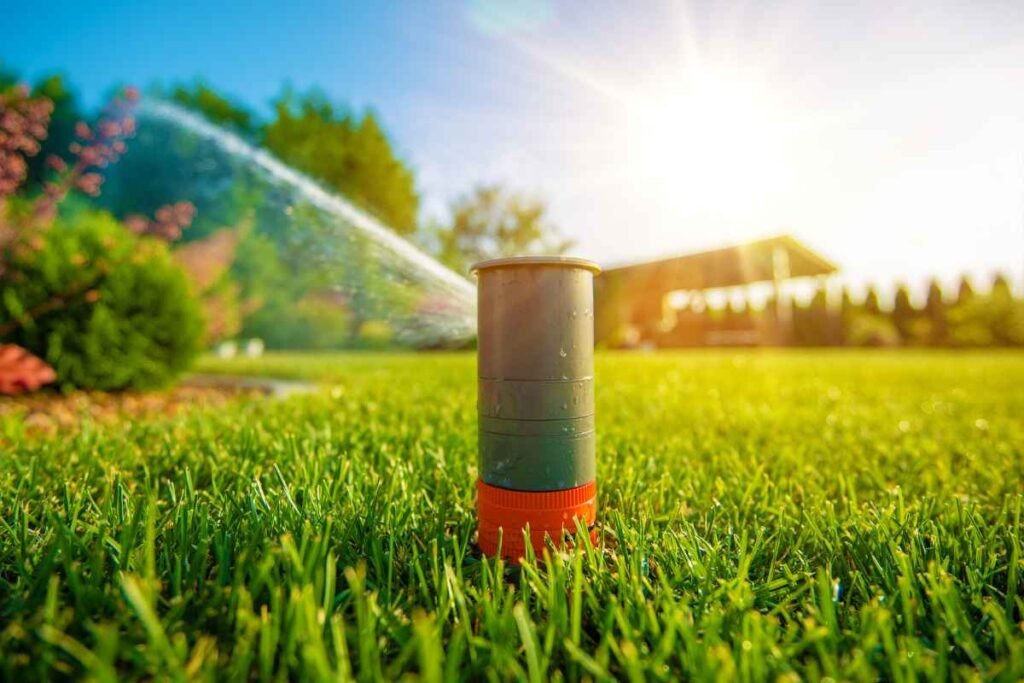Summer brings sunshine and lovely lawns, but it also brings lawn concerns that can damage your turf. Each problem, from crabgrass and dandelions to grubs and ants, demands particular solutions. Summer heat and humidity foster diseases including brown patch, dollar spot, and necrotic ring spot, which may turn dangerous if not treated. Homeowners can use cultural practices like mowing, watering, and fertilizing and specific chemical treatments to address these issues. Integrated pest management (IPM) can reduce pests and diseases and keep lawns healthy all season. Read this concise article to address all of these issues easily.
Summer Lawn Problems And Solutions
Summer diseases
Brown patch
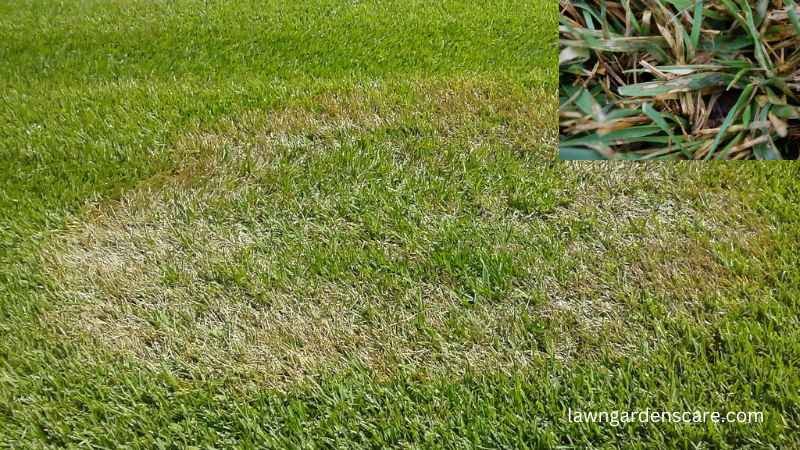
Tall fescue lawns are prone to brown patch lawn disease in summer. The disease flourishes in high humidity and warm temperatures and has circular brown patches with a green center. Excess nitrogen and inadequate air circulation can also cause this condition. Preventative and active treatments are vital to manage brown patches.
- First, appropriate water, mow, and fertilize your lawn to keep it healthy.
- Water your lawn deeply but infrequently in the morning to reduce grass blade wetness and fungus growth.
- Mow at the right height for your grass type and avoid nitrogen-rich fertilizers..
- Azoxystrobin and Propiconazole, which control the Rhizoctonia solani fungus that causes brown patches, can treat the disease. These should be applied according to label guidelines early spring before symptoms appear to prevent outbreaks.
Dollar spot

Dollar spot is a prevalent lawn disease characterized by small, silver dollar-sized tan or brown spots that can merge into larger areas. In late spring and early summer, it thrives in warm temperatures, high humidity, and abundant moisture, especially on nitrogen-poor soil. Effective dollar spot management requires cultural and chemical treatments. Proper lawn care is essential.
- If you mow too short, your lawn can get infected. Mow lawns 3 to 4 inches short and trim one-third of the blade at a time.
- Fertilize your grass, especially with nitrogen in late spring, to strengthen it against the fungus.
- Water deeply but infrequently in the morning to reduce leaf moisture, which promotes dollar spot..
- If an infection has already set in, Propiconazole and other recommended fungicides work. To avoid fungicide resistance, follow label recommendations and rotate fungicides.
Ascochyta leaf blight

Kentucky bluegrass, tall fescue, and perennial ryegrass are susceptible to Ascochyta leaf blight in summer. This fungal disease causes big, straw-colored patches on lawns that can appear overnight, especially during hot, dry spells and cool, rainy spells. Since Ascochyta leaf blight usually resolves without damaging the lawn permanently, proper cultural practices are the main management strategy.
- To develop strong root systems and avoid fungal growth, water deeply and infrequently. The optimal time to water is 12 am to 6 am, 1 to 1.5 hours per zone every third or fourth day.
- Maintain a 2 ½ to 3 inch lawn height and avoid wet mowing to prevent fungus spread. Sharp mower blades prevent grass tearing and fungus penetration.
- Aerate your grass regularly to avoid fungus growth and soil compaction. Aeration improves grass root water penetration and air circulation..
- Maintaining balanced fertilizer can help the grass recover from blight faster by avoiding excessive nitrogen, which promotes delicate growth more vulnerable to diseases.
- Due to its temporary nature, Ascochyta leaf blight is rarely treated with fungicides. Instead, strengthen the grass through cultural practices that improve lawn health.
Fairy rings
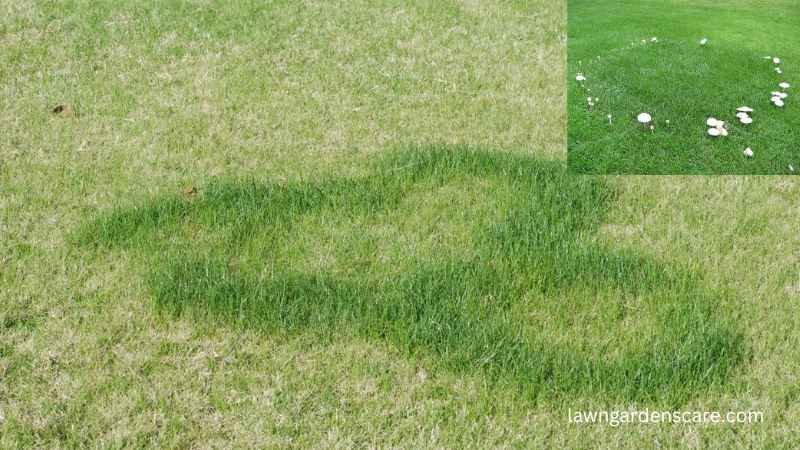
Fairy rings, create circular or arc-shaped mushroom patterns, can cause dead or lush green grass in lawns. Fungi break down organic material in the soil, releasing nutrients that boost grass growth in some sections and dry, hydrophobic conditions in others, forming these rings.
- Aerating the affected area disrupts fungal growth and reduces soil compaction, improving moisture and airflow to the roots.
- Wetting agents can prevent fungal mycelium’s water-repellency. This helps soil absorb water, which is useful for curing Type 1 fairy rings, which make soil hydrophobic.
- Fungicides like Consan 20 or Heritage G can help persistent fairy rings, especially in spring and early summer when the fungus are active.
- In severe cases, replacing affected soil with fresh, sterilized soil can serve as a permanent treatment. But, this is a labor-intensive and costly method.
- Regular lawn mowing, watering, and fertilizing help prevent fairy ring growth. Avoid nitrogen overfertilization, which can worsen it.
To choose the most efficient treatment, you must identify the type of fairy ring (Type 1, 2, or 3 based on their characteristics and grass effects). Although some fairy ring mushrooms are edible, some can be hazardous, thus proper identification is essential before consumption.
Powdery mildew
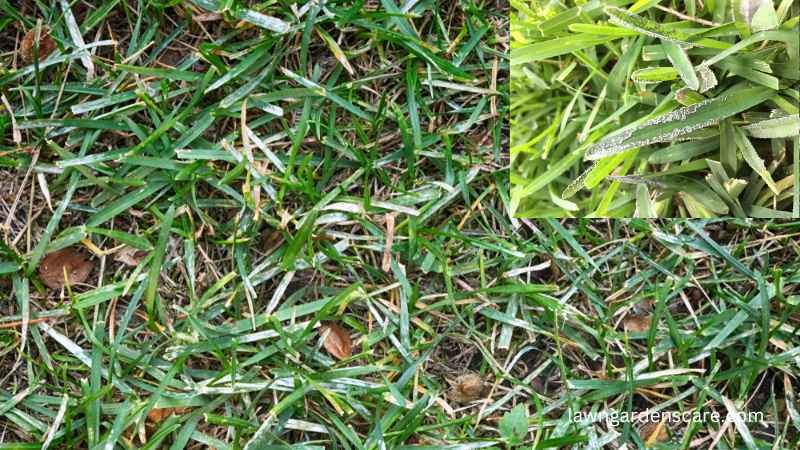
Untreated powdery mildew, which appears as white or grayish patches on grass blades, can spread to cover larger areas. It affects shady, damp, and poorly ventilated lawns. Powdery mildew grows best at 60–70 degrees Fahrenheit but slows down at 90 degrees. To manage powdery mildew, focus on improving the cultural conditions of your lawn.
- Trim or prune overhanging trees and shrubs to reduce shade and improve air movement around the grass.
- Water your lawn in the early morning to reduce moisture retention on the grass blades to discourage fungal growth. Avoid evening watering and water the lawn infrequently.
- Mow at the proper height for your grass type and aerate your lawn to improve soil structure and reduce compactness to prevent fungal diseases.
- If cultural methods are insufficient, fungicides like myclobutanil, propiconazole, or triadimefon are recommended. Natural remedies like neem oil can prevent and recover diseases.
- In severe cases where environmental changes aren’t possible or effective, apply fungicides according to the manufacturer’s directions for safety and efficacy.
Red Thread
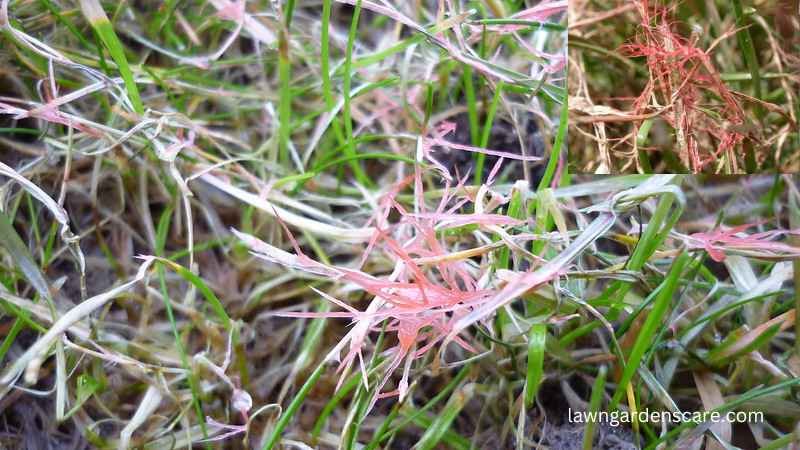
Red Thread, a fungal disease, affects cool-season grasses under cooler, humid conditions. It causes pink to red thread-like formations on grass blades and causes tiny leaves, and circular dead spots on the lawn. This disease typically impacts Kentucky Bluegrass, Perennial Ryegrass, and Fine Fescues.
- Nitrogen-deficient lawns can worsen Red Thread, so avoid it. Applying nitrogen-rich summer fertilizer can improve grass health and disease resistance. Maintaining good cultural practices, including frequent mowing at the right height, soil fertility and pH, and increased air circulation by eliminating shade, are essential.
- Apply fungicides when cultural approaches fail. Use Red Thread-specific products like zoxystrobin, penthiopyrad, polyoxin D, propiconazole and follow label recommendations for effective control.
- Regular lawn management, fertilizer, and targeted fungicide usage will help control Red Thread and keep your lawn healthy and beautiful..
Summer patch

Summer patch, caused by Magnaporthiopsis poae, is a difficult lawn disease that affects Kentucky bluegrass, annual bluegrass, and fine fescues in hot, humid weather. The condition is characterized by circular areas of dead grass, frequently reddish-brown, surrounded by healthy grass. Summer patch management requires preventive care and cultural practices that improve lawn health.
- Deep yet infrequent watering encourages deeper root growth, which resists infections. Watering early in the morning reduces evaporation and leaf wetness duration.
- Give your lawn enough nutrients, especially potassium, to grow roots. Excess nitrogen in spring and fall can encourage lush growth but hamper root development.
- Keep your grass at the right height to avoid stress and disease. Do not cut more than one-third of the grass blade at once.
- Aeration and dethatching promote soil drainage and minimize thatch (a layer of organic matter where fungi can thrive). Aerating your lawn allows roots to breathe and develop deeper by reducing soil compaction.
- Perennial ryegrass and tall fescue are resistant to summer patch, so overseeding with these may help in repeated summer patch issues.
- Azoxystrobin or propiconazole may work for active infections. Please apply these products at the outset of disease symptoms and follow up as advised on the product label.
Leaf spot
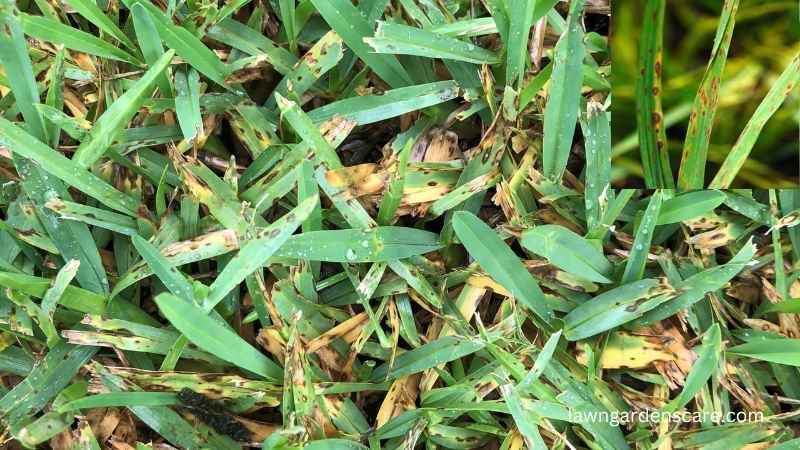
In summer, warm, humid temperatures and long grass blade wetness promote fungal growth, causing leaf spot. This disease causes black or purple lesions on grass and can lead to “melting-out,” where grass rots, especially in summer.
- Water your lawn in the morning to allow it to dry before evening temps drop. This reduces fungal growth-promoting wetness. Water grass deeply but infrequently to promote healthy root systems and prevent over-watering.
- Keep grass at a higher cutting height during leaf spot seasons. Your lawn’s health and stress tolerance improve with this approach. Keep your mower blades sharp to avoid damaging grass and spreading the disease.
- Keeping your lawn healthy helps prevent leaf spot. Proper soil management involves frequent aeration, careful fertilization to avoid nitrogen overuse, and dethatching to prevent moisture and pathogens.
- If the disease has grown or your area is prone to leaf spot, apply a fungicide. Active ingredients like Iprodione, Chlorothalonil, and Azoxystrobin work well. Early application of these products is essential, ideally before the disease fully establishes during high-risk periods.
Snow mold

Snow mold is a fungal lawn disease that appears when snow melts. It survives under snow and forms gray or pink snow mold. Gray snow mold damages grass blades and causes grayish patches on the lawn. Pink snow mold, characterized by pinkish or rust-colored patches, may become more harmful to grass roots and blades.
- Gently rake snow mold-affected areas to break up matted grass to speed up soil drying. This may work for gray snow mold because grass usually recovers on its own when soil dries.
- Pink snow mold can harm grass badly, and need intensive care like reseeding or resodding.
- Keep debris and leaves off the lawn, maintaining proper drainage, and apply a fall fungicide if your area is prone to snow mold. To avoid fungus growth, cut your lawn at the right height before snowfall to prevent matting.
Lawn rust
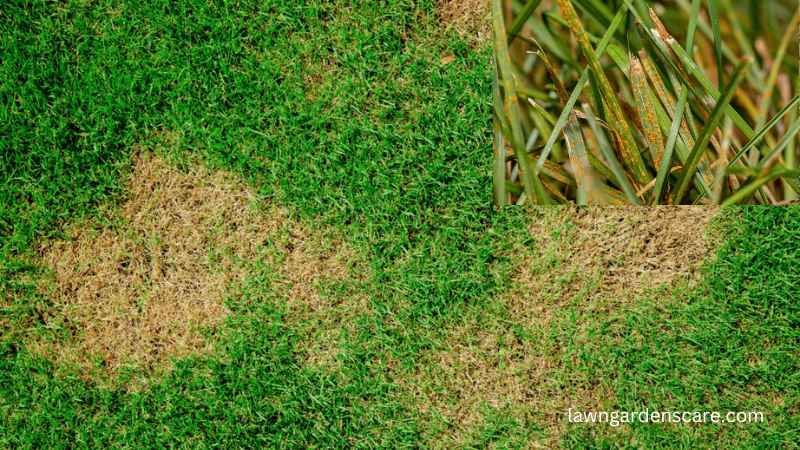
A fungal disease called lawn rust arises in summer and autumn, especially under humid conditions. This fungus generates orange or yellow patches on grass and thins your lawn. Rust spores stick to shoes and garments easily, making it quite noticeable.
- Nitrogen-rich fertilizers enhance lawn vitality and reduce rust risk. Fertilizing your lawn regularly during the growing season is crucial for its health.
- Aeration and irrigation are also important lawn maintenance practices. Aerating your grass improves soil drainage and decreases compaction, which promotes rust. Deep, infrequent watering, ideally in the morning, lets the grass dry throughout the day. This decreases lawn wetness, preventing rust formation.
- Cutting overhanging trees and shrubs can improve air circulation, boost sunlight exposure, and minimize grass wetness, reducing rust growth.
Necrotic Ring Spot
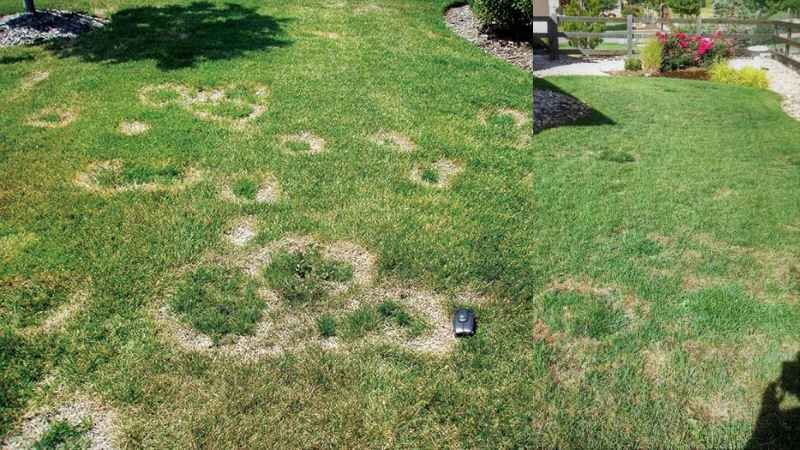
The fungus Ophiosphaerella korrae causes Necrotic Ring Spot (NRS), mostly affects cool-season grasses like Kentucky Bluegrass and Fine Fescue.
- Compacted soil makes the lawn more susceptible to NRS. Aerating the lawn improves root growth and water, nutrient, and air availability by reducing soil compaction.
- Raising your mower height allows higher grass, which improves root depth and turf health. Remove only one-third of the grass blade at a time to avoid stressing the grass.
- Deep and infrequent watering promotes deeper root systems, which help grass deal with NRS stress.
- Excessive nitrogen levels can exacerbate NRS issues. Use a balanced, slow-release fertilizer that offers enough nutrients without increasing nitrogen.
- Propiconazole, myclobutanil, and thiophanate-methyl may cure existing infections. These should be used according to disease severity and manufacturer directions. It’s recommended to start treatments in the spring when soil temperatures reach around 65 degrees Fahrenheit.
- Sulfur can lower soil pH, inhibiting NRS pathogen growth. You should do it carefully to avoid soil acidification.
- Overseeding with resistant Kentucky Bluegrass or perennial ryegrass helps reduce NRS in your lawn.
- For severe or persistent situations, a professional lawn care firm can design a treatment plan to your lawn’s condition and needs.
Summer pests
Summer pests including grubs, chinch bugs, mole crickets, and ants can damage lawns. Controlling each pest demands specific methods.
Grubs

Grubs, the larvae of various scarab beetles like Japanese Beetles and June Bugs, are a common lawn issue during the summer. These pests attack grass roots, causing brown spots and sponginess. Early detection and treatment are essential for grub management.
- Look for unusual brown patches on your grass and use the shovel test to identify grubs. More than five grubs per square foot indicate an infestation that requires attention.
- Treatment strategies vary by season and infestation level. Early spring preventative treatments with Acelepryn, which is harmless for wildlife, are ideal. This helps prevent grubs from becoming harmful beetles.
- Curative treatments in late summer or early fall are advised for active grubs. Dylox-containing products work fast. To maximize effectiveness, apply these treatments at peak grub activity.
- Aerating and watering a lawn can prevent grubs in addition to chemical treatments. Beetles are less likely to lay eggs in your grass if you reduce irrigation during egg-laying season (June and August).
Ants
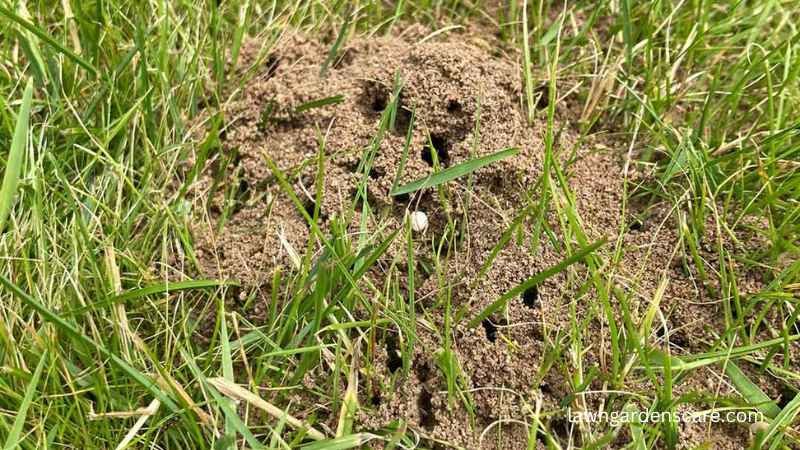
Summer lawn ant control requires natural approaches and tailored insecticides.
- Sprinkle non-toxic diatomaceous earth around ant nests or pathways. It dehydrates ants by damaging their exoskeletons. This approach is safe for pets and children and effective with repeated applications.
- Bifenthrin or permethrin may work for severe infestations. As contact insecticides with persistent effects, these compounds will keep working. Use these products on ant mounds or lawns as directed on the label. Be cautious while using these products since they can harm aquatic life and bees. Avoid areas near water bodies or during peak bee activity hours.
- Using a leaf rake to disperse soil to minimize ant mounds and reduce their visibility. This strategy reduces lawn scalping when mowing and can enhance its beauty quickly without chemicals.
- Keeping your yard healthy can also deter ants. Regular mowing, irrigation, and soil health help deter ants from your lawn. Eliminating extra moisture and dirt can also decrease ant activity.
Chinch bugs
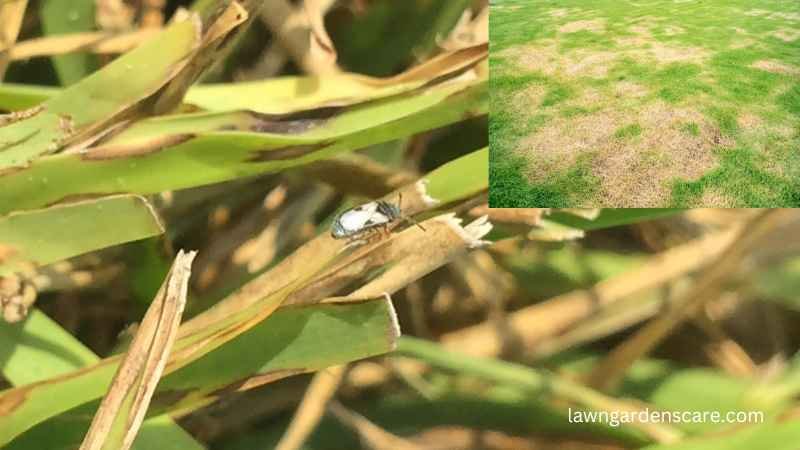
Chinch bugs, microscopic pests that feed on grass nutrients, can damage lawns in summer by turning them yellow and brown. Effective chinch bug management combines prevention and active management. To recognize chinch bugs, search for tiny insects with dark bodies and white wings. They are often found in dry, hot conditions and detected through their damage rather than direct observation.
- A healthy lawn is essential. Chinch insect infestations are often prevented by regular mowing, eliminating thatch, and watering. To reduce the habitat for chinch bugs, it is recommended to remove thatch (a layer of organic materials above the soil).
- Insecticidal soaps are less harmful and dehydrate chinch bugs by breaking down their outer layers. Also, you can spread diatomaceous earth on the lawn to harm the bugs physically.
- As a last resort, use insecticides if natural techniques fail. Long-lasting bifenthrin-based chinch bug control products work well. Proper usage of these chemicals is crucial to prevent harm to beneficial insects and prevent bug resistance.
- Check your lawn for chinch bug activity regularly. This includes checking for bugs and yellowing patches. Early detection allows for intervention before major damage.
Mole crickets
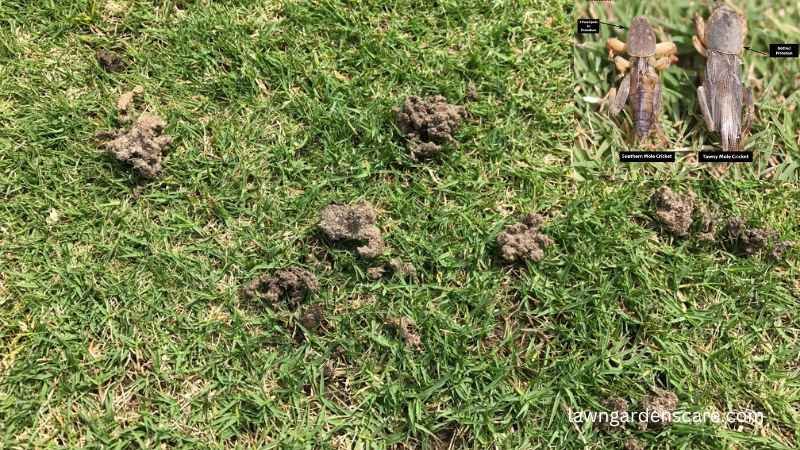
In summer, mole crickets may become a major pest in your yard. These insects’ extensive tunneling can harm grass roots and leave spongy patches on your lawn.
- Use natural ways before pesticides to control mole crickets. Entomopathogenic nematodes, such as Steinernema carpocapsae, can kill mole crickets without affecting beneficial insects. Nematodes are most effective in late summer or early fall, when mole cricket nymphs are at their peak activity.
- If nematodes fail, try a targeted pesticide. Proper use of bifenthrin can suppress mole crickets and give residual control. Applying these products to moist soil ensures the insecticide reaches mole crickets. Water your grass 1-2 inches a few days before applying insecticide to ensure enough soil moisture.
- Mowing, dethatching, and fertilizing your grass regularly can also make it less inviting to mole crickets and more resistant to their harm.
Summer weeds
Summer weed control is difficult because herbicides can damage your lawn in high temps. Here are some successful weed control methods:
- Applying a pre-emergent pesticide in spring before temps rise is essential to preventing summer weeds. These pesticides reduce summer weed load by preventing weed seed germination.
- Manual eradication of existing weeds is safe and effective. Using a weed puller can make weeding easier without strain. You must remove the roots completely to prevent regrowth.
- Choose herbicide timing and type carefully if chemical intervention is necessary. Apply post-emergent herbicides in cooler situations, such as early morning or late evening, to minimize the impact on desirable plants and maximize the uptake by weeds.
- Targeted treatments can work for dandelions and clover. Broadleaf weeds like dandelions need 2-4-D products. Spring pre-emergent herbicide with corn gluten meal can prevent weed seeds from developing organically.
- Keeping your grass healthy and dense is one of the best strategies to fight weeds. Regular mowing, fertilizing, and watering improve your lawn, decreasing weed growth and establishment.
Crabgrass
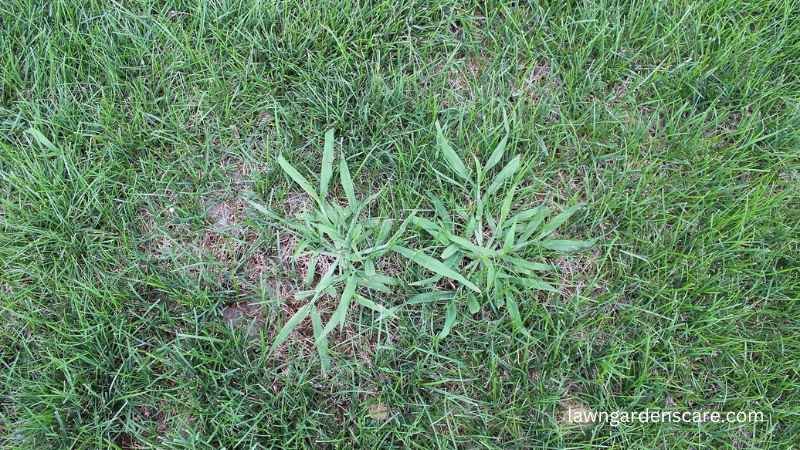
Crabgrass grows swiftly and spreads, making it a typical summer weed.
- To prevent crabgrass seeds from growing, apply pre-emergent herbicides in early spring. The soil surface receives protection from crabgrass by these pesticides. Application of herbicides should occur when daytime temperatures exceed 65°F to 70°F for several days, typically during azalea and dogwood blooming.
- Post-emergent herbicides can kill crabgrass after it appears. Active compounds like Quinclorac are ideal for crabgrass control without hurting your lawn.
- Maintaining a healthy lawn is your best defense against crabgrass. Proper lawn care involves mowing at the right height, watering deeply but not frequently, and fertilizing for weed resistance.
- Pulling crabgrass manually can be effective in small infestations. Complete root system removal is most effective when soil is moist, such as after rain, to prevent regrowth.
Dandelions

Summer lawns are plagued with dandelions, but there are various efficient ways to control them.
- Manually removing dandelions with a weeding knife or grubber removes the root and prevents regrowth. This method works best in moist soil.
- Mowing small plants before seeding helps to prevent seed spreading.
- Herbicides work for greater infestations. Fall broadleaf herbicides like 2,4-D, dicamba, or MCPP work against dandelions because they are absorbed by the plant and carried to the roots. Systemic herbicides harm the entire plant, including roots.
- Applying pre-emergent herbicides like Mesotrione or Prodiamine in spring can inhibit dandelion germination and provide long-term control.
- Maintaining a thick, lush lawn by mowing, fertilizing, and watering reduces dandelions’ growth area. Tall lawn grass prevents sunlight for dandelion seed growth.
- Consider using maize gluten flour as a natural pre-emergent pesticide to prevent dandelion seeds from growing early in the season.
- To kill dandelions, vinegar can be used as a spot treatment, but be cautious as it might harm grass and other plants.
Summer stresses
Drought
Managing summer drought stress in your lawn needs appropriate lawn maintenance and smart irrigation. Even in dry weather, you can help your grass recover and thrive.
- Water your lawn deeply but not frequently to combat drought stress. This promotes deeper root growth, which helps your lawn get water from deeper soil. Apply 1 inch of water per week, either all at once or in two sessions. For optimal results, water deeply in the morning to minimize evaporation.
- Raising your lawn mower height lets grass blades grow longer. Longer grass blades shade the soil, enabling deeper roots and moisture retention. It also shields the lawn from the harsh sun.
- In dry conditions, aerating your grass improves water infiltration and air penetration to the root zone. Thatch removal improves soil water and nutrient uptake.
- Fertilizer during droughts might boost growth when grass should be conserving energy. Decrease foot traffic on strained lawns to prevent further harm to weaker grass.
- After the drought, overseed with drought-resistant grass to strengthen your lawn. Consider optimizing your lawn care schedule for drought resilience at this time.
Compacted soil
Compacted soil can harm your lawn, especially in summer when you want it to look its best.
- Aeration is the best soil compaction remedy. A core aerator, which removes soil plugs, works best for air, water, and nutrient penetration. The grass should recover quickly by doing this during its peak growing season. For smaller or weakly compacted areas, a manual garden fork works too..
- Aerating your lawn and adding a thin layer of compost or topsoil improves soil structure. This topdressing fills aeration gaps and integrates organic matter into the soil, improving fertility and water retention.
- Organic matter, not sand, helps break down compaction in clayey soil. Compost and peat moss feed the soil and prevent it from hardening.
- To reduce compaction, eliminate high foot traffic, irrigate your lawn, and mow it at the right height.
Last Words
Addressing summer lawn problems effectively demands a proactive and knowledgeable approach. Managing invasive weeds, harmful pests, and fungal diseases can be done with targeted lawn care products. Healthy turf maintenance requires proper mowing, watering, and fertilizing. Preventive and proactive treatments ensure your lawn survives and thrives in summer. Homeowners may keep lush, healthy lawns that are attractive and season-resistant by understanding and applying these strategies.
References:
- Northwest District IFAS Extension
- RHS (Royal Horticultural Society)
- Simple Lawn Solutions
- Bob Vila
- Advanced Turf Solutions
- This Old House
- Scotts
- Penn State Extension
- Bioadvanced
- Sod Solutions
- Illinois Extension
- Jonathan Green
- OSU Extension Service
- LawnStarter
- Fairway Green Inc.
- CSU Extension
- GardeningKnowHow
